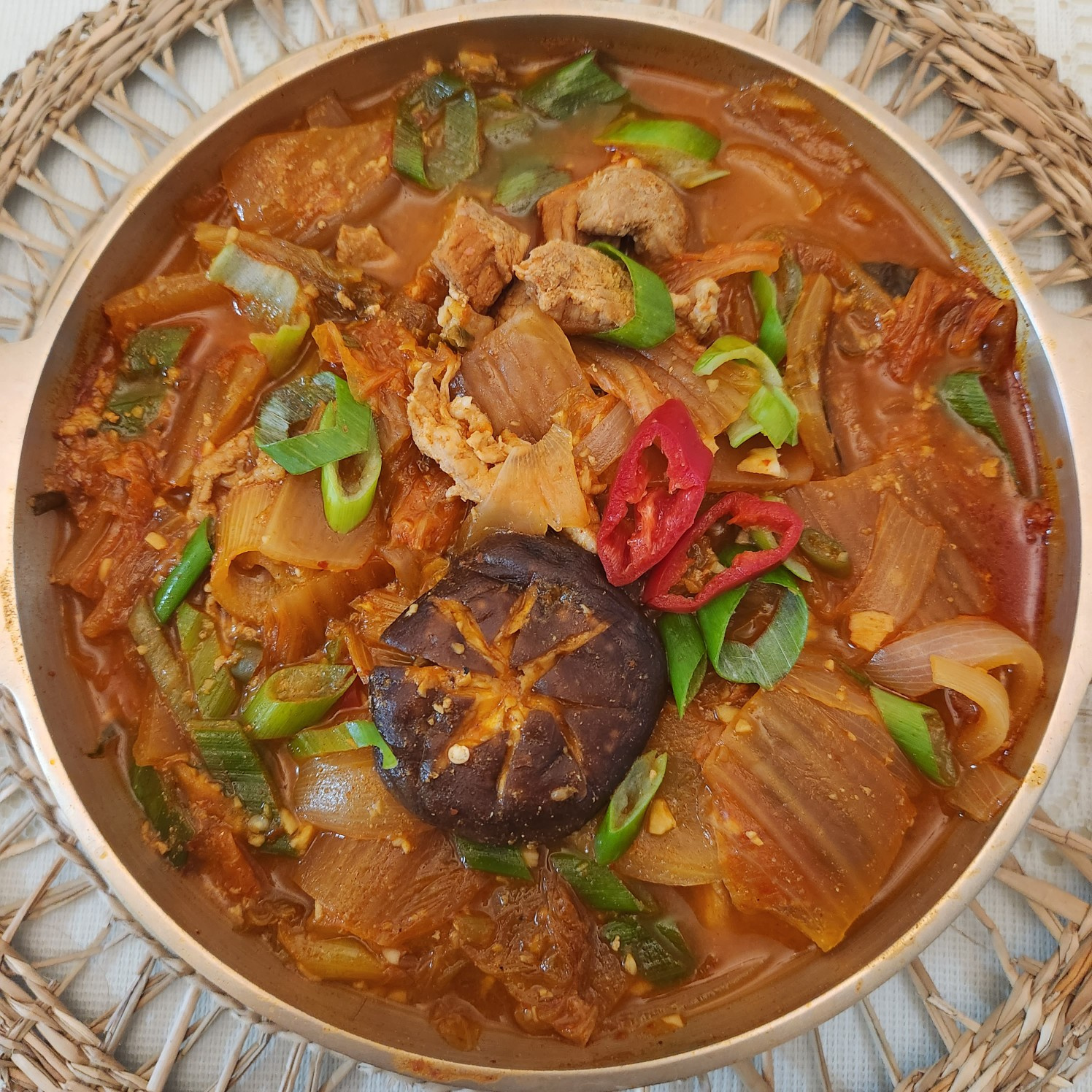Spicy Pork and Kimchi Stew with Gochujang
[Gochujang Pork Kimchi Stew] A Hearty and Refreshing Gochujang Pork Kimchi Stew Perfect for After Chuseok Festivities

Hello! It’s Nanhee. As the weather cools down, I find myself craving warm, comforting soup. Kimchi stew, a quintessential Korean dish, is always a delicious choice. After indulging in rich and greasy holiday foods, a refreshing and spicy kimchi stew can really cleanse your palate and make you feel revitalized. Today, I’m sharing a recipe for a hearty pork and kimchi stew, made with leftover aged kimchi and plenty of pork. Let’s simmer it until it’s bubbling and delicious!
Main Ingredients- 1000g Pork (shoulder or belly, cut for stew)
- 1/4 head Aged Kimchi (approx. 400g)
- 1 Onion (medium-sized)
- 1 Scallion (or Green Onion)
- 3 Korean Green Chilies (Cheongyang peppers)
- 1.2L Broth (anchovy-kelp or water)
Seasonings & Condiments- 2 Tbsp Minced Garlic
- 1 Tbsp Korean Soy Sauce for Soup (Guk Ganjang)
- 1 Tbsp Fish Sauce (Tuna or Anchovy)
- 3 Tbsp Gochujang (Korean chili paste)
- 1 Tbsp Sugar (to balance the sourness of aged kimchi and add depth)
- 2 Tbsp Minced Garlic
- 1 Tbsp Korean Soy Sauce for Soup (Guk Ganjang)
- 1 Tbsp Fish Sauce (Tuna or Anchovy)
- 3 Tbsp Gochujang (Korean chili paste)
- 1 Tbsp Sugar (to balance the sourness of aged kimchi and add depth)
Cooking Instructions
Step 1
First, prepare all the ingredients for the kimchi stew. Fresh ingredients are the foundation for a delicious stew.

Step 2
Prepare 1/4 head of well-fermented aged kimchi (about 400g). The sourness and savory flavor of aged kimchi determine the stew’s character, so choose a piece that is nicely fermented. Cut the kimchi into bite-sized pieces.

Step 3
Thinly slice the onion. Finely chop the Korean green chilies for a spicy kick. Slice the scallion diagonally, separating the white and green parts. Prepping the vegetables like this will make the cooking process much smoother.

Step 4
We’ll use a generous 1000g of pork for a rich and flavorful stew. I’m using Jeju pork, which is often sold in convenient 500g vacuum-sealed packs, perfect for stew. Cut the pork into bite-sized pieces.

Step 5
Take a large, deep pot. Add the sliced pork and 2 tablespoons of minced garlic. Turn the heat to high and start stir-frying the pork. The garlic aroma will meld with the pork, enhancing its flavor.

Step 6
Continue to stir-fry the pork until its surface is golden brown and it has released some of its fat. Stir-frying the pork thoroughly helps eliminate any gamey smell and adds a richer, nuttier taste.

Step 7
Now, add 3 tablespoons of gochujang. Gochujang is the key ingredient that gives kimchi stew its spicy depth and rich flavor.

Step 8
Stir-fry for about 1-2 minutes over medium heat until the gochujang is well combined with the pork. Be careful not to burn the gochujang; stir-frying it properly ensures a clean, non-bitter taste.

Step 9
Now, add the prepared aged kimchi to the pot. We’ll stir-fry it together with the gochujang seasoning.

Step 10
Add 1 tablespoon of sugar. Sugar helps to neutralize the strong sourness of the aged kimchi and balances the overall flavor of the stew, contributing to a deeper, smoother taste.

Step 11
Once the pork and kimchi are sufficiently stir-fried, pour in 1.2 liters of broth (anchovy-kelp or plain water). Using broth will add more depth to the soup. Adding a generous amount of liquid and simmering for a long time allows the flavors to fully develop.

Step 12
Add the thinly sliced onion. The natural sweetness of the onion will further enrich the overall flavor profile of the kimchi stew.

Step 13
Add the chopped Korean green chilies for a spicy and zesty flavor. Adjust the amount to your preference if you like it spicier.

Step 14
Now it’s time to season. Since the saltiness and fermentation level of kimchi can vary, it’s best to start with a small amount of soy sauce and fish sauce and adjust to taste. Add 1 tablespoon of Korean soy sauce for soup to enhance the umami.

Step 15
Add another tablespoon of fish sauce (tuna or anchovy). Fish sauce is a secret ingredient that adds deep savory notes and a refreshing quality to kimchi stew.

Step 16
Bring the kimchi stew to a rolling boil over high heat, then reduce the heat to medium-low and let it simmer gently for about 10 minutes. It’s important to simmer until the ingredients are tender and the flavors have fully melded.

Step 17
Finally, add the diagonally sliced scallions and simmer for another moment before turning off the heat. The fragrant aroma of the scallions will complete the dish.

Step 18
Your spicy and deeply flavorful Gochujang Pork Kimchi Stew is ready!

Step 19
Serve generously in bowls alongside hot rice for a truly delightful meal. The refreshing and spicy broth is a perfect match for warm rice, making it easy to finish a whole bowl! What could be a better comfort food on a cool day?




